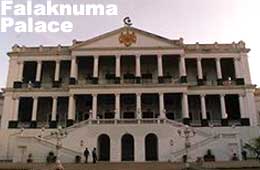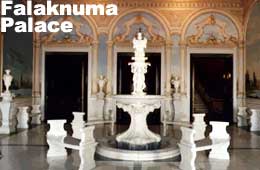| India Profile » Monuments and Temples in India » Falaknuma Palace | |
Falaknuma Palace | |
 | |
 The Falaknuma Palace or the Mirror of the Sky is the one of the finest palaces of Hyderabad. It is situated on a 2000 ft high hill at a distance of 5 km from Char Minar. It was built in 1883-84 AD by Nawab Vikar-ul-Umra Bahadur, who was the fifth Amir of Paigah and the prime Minister of Hyderabad. The Sixth Nizam purchased it in 1897 AD to use it as the royal Guest House. Nowadays it belongs to Nawab Mukarramjah Bahadur, the grandson of seventh Nizam. An Italian architect designed the Falaknuma Palace. The influences of various styles can be seen in the palace as the Nawab was an avid traveler. It a fine blend of the Italian and Tudor architecture. The foundation of the palace was laid on the 3rd March 1884 and took 9 years to complete it. The palace was designed in the shape of a scorpion with its two wings spread out on the north. The main building is in the middle part while the kitchen and the harem quarters are towards the south. However, the building yielded to many additions and alterations by its later occupants. The d�cor style of Louis XIV co-exists with the lavish Munhall ambiance, Italian marble staircases and ornate fountains. The Nawab Mir Osman Ali Khan Bahadur, who succeeded Nizam VII, changed the decor of the palace. A well-laid out garden is in front of the palace. The windows of the palace are stained and allow a spectrum of colors along with the light into the room. There is a library in the palace, which has a walnut carved roof and is a replica of the one at Windsor Castle. The library had one of the finest collections of the holy Quran in India. The palace also has largest Venetian chandeliers. It is generally said that it takes six months to clean a 138-arm Osler chandelier and the palace has 40 such chandeliers decorating the halls. The huge dining hall of the palace could accommodate 100 guests on a single table. The chairs are made from rosewood and green leather upholstery. The tableware was made of gold and crystal. Osler introduced the telephone and electrical system in the palace in1883. The palace has one of the largest electrical switchboards in India.
The palace has a ballroom, which contains a two-ton manually operated organ. This organ is said to be the only one of its kind in the world. Apart from this, the palace has 220 rooms extravagantly decorated and 22 spacious halls. The palace has some of the finest treasures accumulated by the Nizam. The Falaknuma Palace has a display of a large collection including paintings, statues, furniture, manuscripts and books. The Jade collection of the Palace is considered to be unique in the world. The palace was the owned by the Nizam's family earlier and thus the visitors were not allowed. The palace occasionally opened for public view. |
|
 |
 The living quarters of the palace are in the ground floor. The interior of the main building has an Italian marble staircase supporting marble figures, lined with portraits of British Governor Generals. The staircase made of marble leads to the upper floor. The staircase has carved balustrades which supports marble figures with candelabra at regular distance. The murals bordered with gilded relief decorate the ceiling of the reception room in the upper floor. One can see a panoramic view of the city from this floor.
The living quarters of the palace are in the ground floor. The interior of the main building has an Italian marble staircase supporting marble figures, lined with portraits of British Governor Generals. The staircase made of marble leads to the upper floor. The staircase has carved balustrades which supports marble figures with candelabra at regular distance. The murals bordered with gilded relief decorate the ceiling of the reception room in the upper floor. One can see a panoramic view of the city from this floor.